|
CHAPTER XII.
HOW THE ADMIRAL PLAYED ROBINSON CRUSOE.
The True Story of Christopher Columbus, Called the Great Admiral | ||
12.
CHAPTER XII.
HOW THE ADMIRAL PLAYED ROBINSON CRUSOE.
WHILE the terrible storm that wrecked the great gold fleet of the governor was raging so furiously, Columbus with his four ships was lying as near shore as he dared in a little bay farther down the coast of Hayti. Here he escaped the full fury of the gale, but still his ships suffered greatly, and came very near being shipwrecked. They became separated in the storm, but the caravels met at last after the storm was over and steered away for the island of Jamaica.
For several days they sailed about among the West India Islands; then they took a westerly course, and on the thirtieth of July, Columbus saw before him the misty outlines of certain high mountains which he supposed to be
Just turn to the map of Central America in your geography
and find Honduras. The mountains, you see, are
marked there; and on the northern coast, at the head of a
fine bay, you will notice the seaport town of Truxillo. And
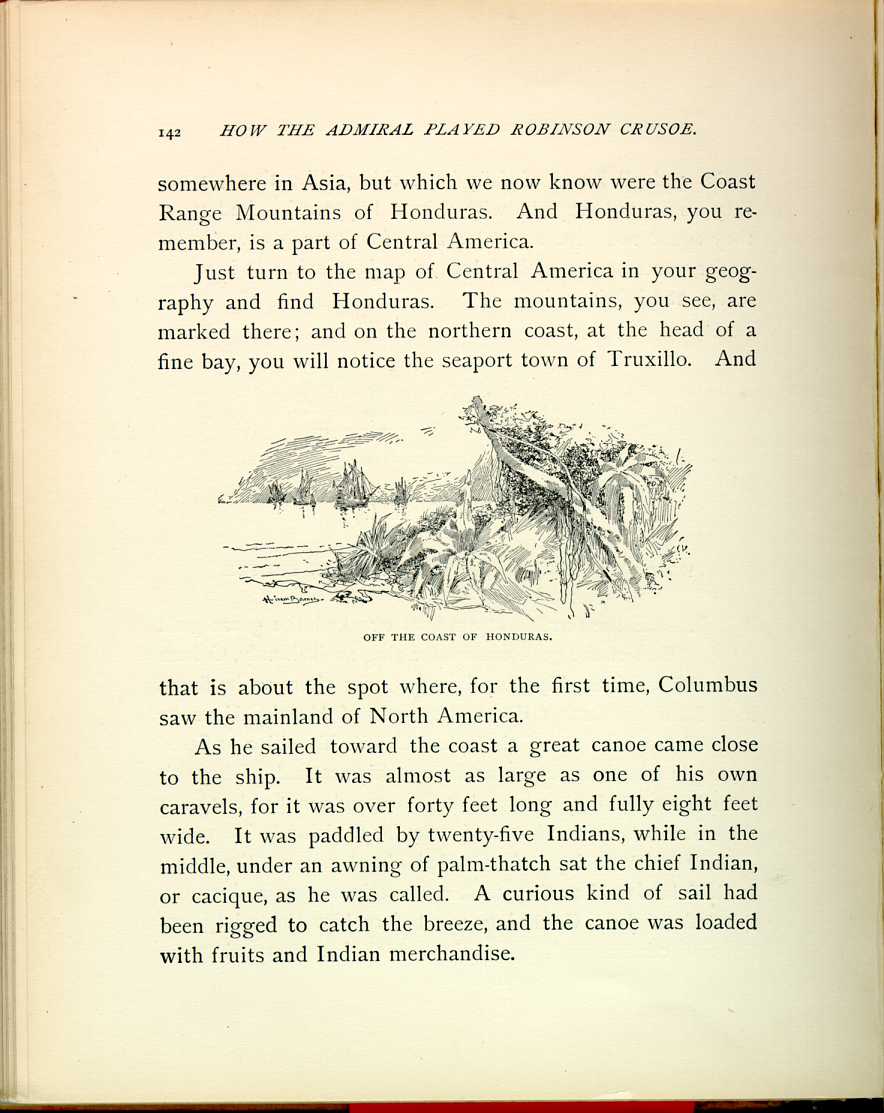
OFF THE COAST OF HONDURAS.
[Description:
Drawing of several ships off the Honduran coast.
]
As he sailed toward the coast a great canoe came close to the ship. It was almost as large as one of his own caravels, for it was over forty feet long and fully eight feet wide. It was paddled by twenty-five Indians, while in the middle, under an awning of palm-thatch sat the chief Indian, or cacique, as he was called. A curious kind of sail had been rigged to catch the breeze, and the canoe was loaded with fruits and Indian merchandise.
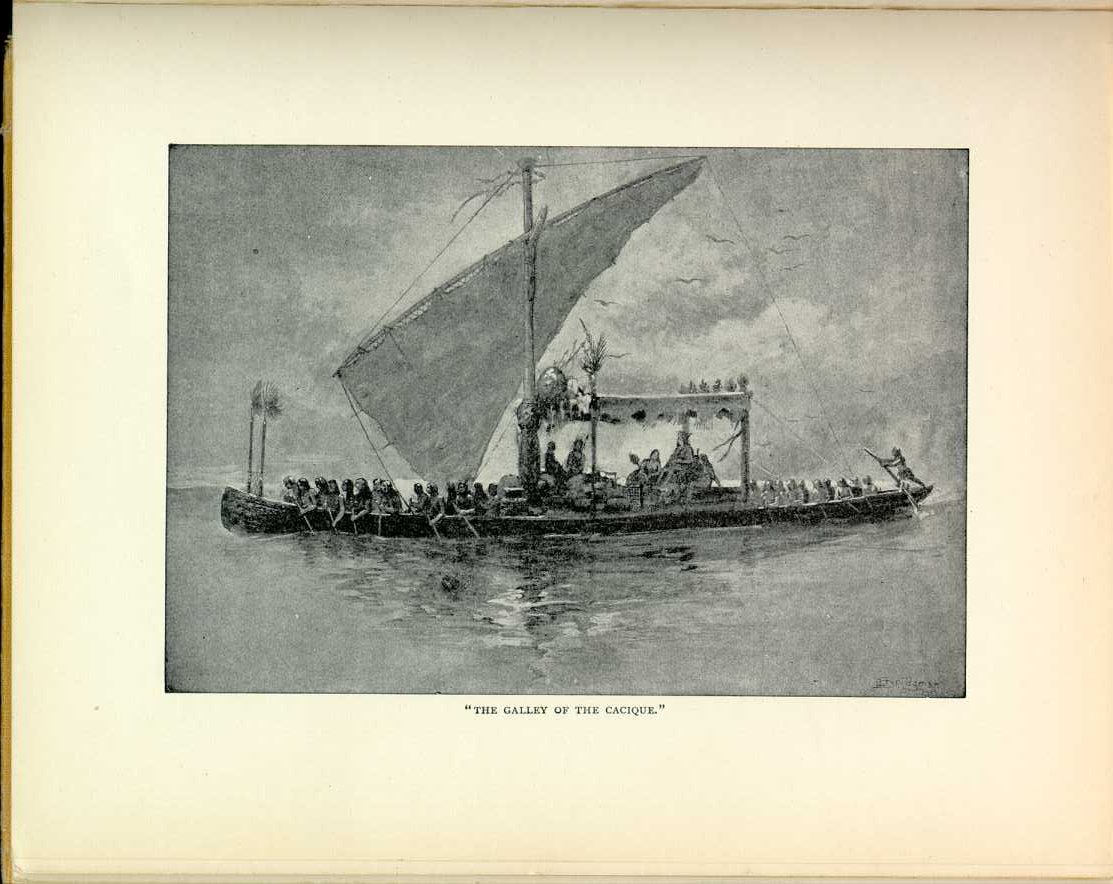
Drawing of a large canoe paddled by a number of Native Americans. The chief and several other figures sit under an awning in the middle of the canoe.
[Description: Drawing of the outside of the Alhambra. ]This canoe surprised Columbus very much. He had seen nothing just like it among the other Indians he had visited. The cacique and his people, too, were dressed in clothes and had sharp swords and spears. He thought of the great galleys of Venice and Genoa; he remembered the stories that had come to him of the people of Cathay; he believed that, at last, he had come to the right place. The shores ahead of him were, he was sure, the coasts of the Cathay he was hunting for, and these people in "the galley of the cacique" were much nearer the kind of people he was expecting to meet than were the poor naked Indians of Hayti and Cuba.
In a certain way he was right. These people in the big canoe were, probably, some of the trading Indians of Yucatan, and beyond them, in what we know to-day as Mexico, was a race of Indians, known as Aztecs, who were what is called half-civilized; for they had cities and temples and stone houses and almost as much gold and treasure as Columbus hoped to find in his fairyland of Cathay. But Columbus was not to find Mexico. Another daring and cruel Spanish captain, named Cortez, discovered the land, conquered it for Spain, stripped it of its gold and treasure, and killed or enslaved its brave and intelligent people.
After meeting this canoe, Columbus steered for the distant shore. He coasted up and down looking for a good harbor, and on the seventeenth of August, 1502, he landed as has been told you, near what is now the town of Truxillo,
For the first time in his life Columbus stood on the real soil of the New World. All the islands he had before discovered and colonized were but outlying pieces of America. Now he was really upon the American Continent.
But he did not know it. To him it was but a part of
Asia. And as the main purpose of this fourth voyage was
to find a way to sail straight to India—which he supposed
lay somewhere to the south—he set off on his search. The
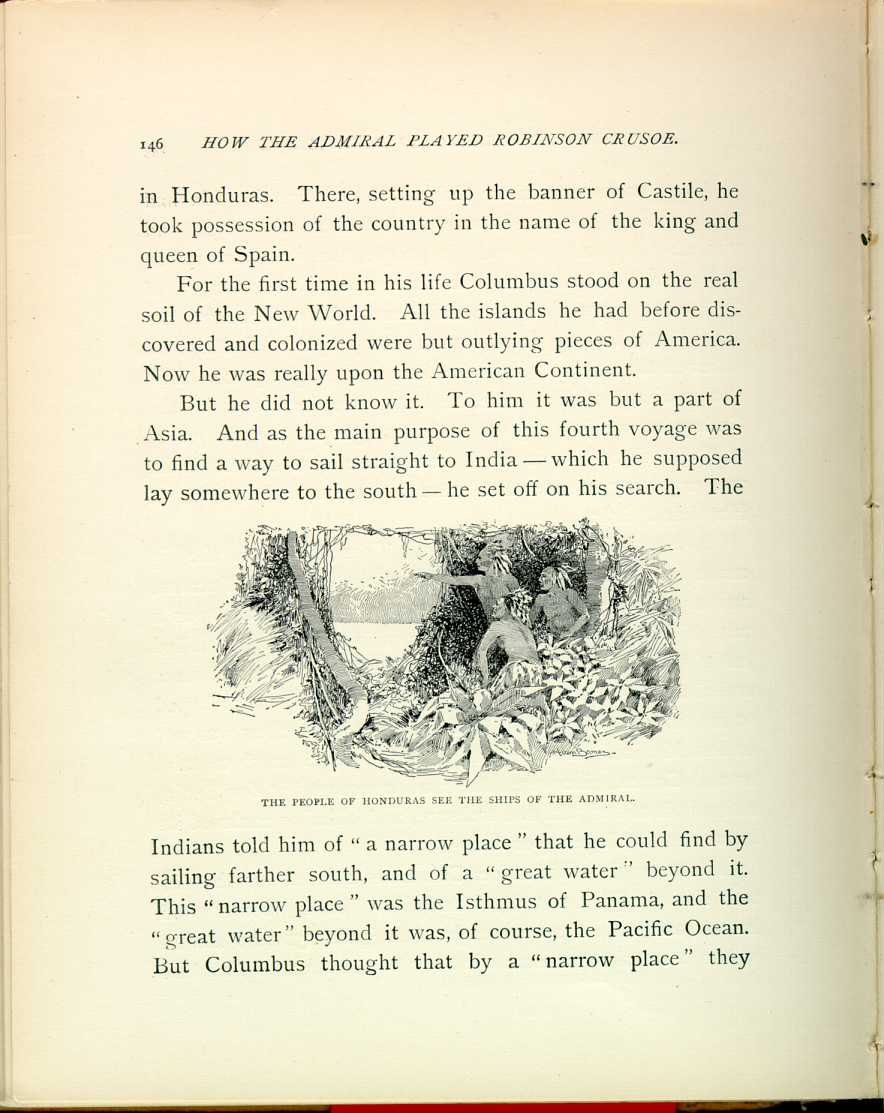
THE PEOPLE OF HONDURAS SEE THE SHIPS OF THE ADMIRAL.
[Description:
Drawing of several Hondurians looking toward the ocean.
]
So he sailed along the coasts of Honduras and Nicaragua trying to find the strait he was hunting for. Just look at your map and see how near he was to the way across to the Pacific that men are now digging out, and which, as the Nicaragua Canal, will connect the Atlantic and the Pacific Oceans. And think how near he was to finding that Pacific Ocean over which, if he could but have got across the Isthmus of Panama, he could have sailed to the Cathay and the Indies he spent his life in trying to find. But if he had been fortunate enough to get into the waters of the Pacific, I do not believe it would have been so lucky for him, after all. His little ships, poorly built and poorly provisioned, could never have sailed that great ocean in safety, and the end might have proved even more disastrous than did the Atlantic voyages of the Admiral.
He soon understood that he had found a richer land than the islands he had thus far discovered. Gold and pearls were much more plentiful along the Honduras coast than they were in Cuba and Hayti, and Columbus decided that, after he had found India, he would come back by this route and collect a cargo of the glittering treasures.
The land was called by the Indians something that sounded very much like Veragua. This was the name
But as Columbus sailed south, along what is called "the
Mosquito Coast," the weather grew stormy and the gales
were severe. His ships were crazy and worm-eaten; the
food was running low; the sailors began to grumble and
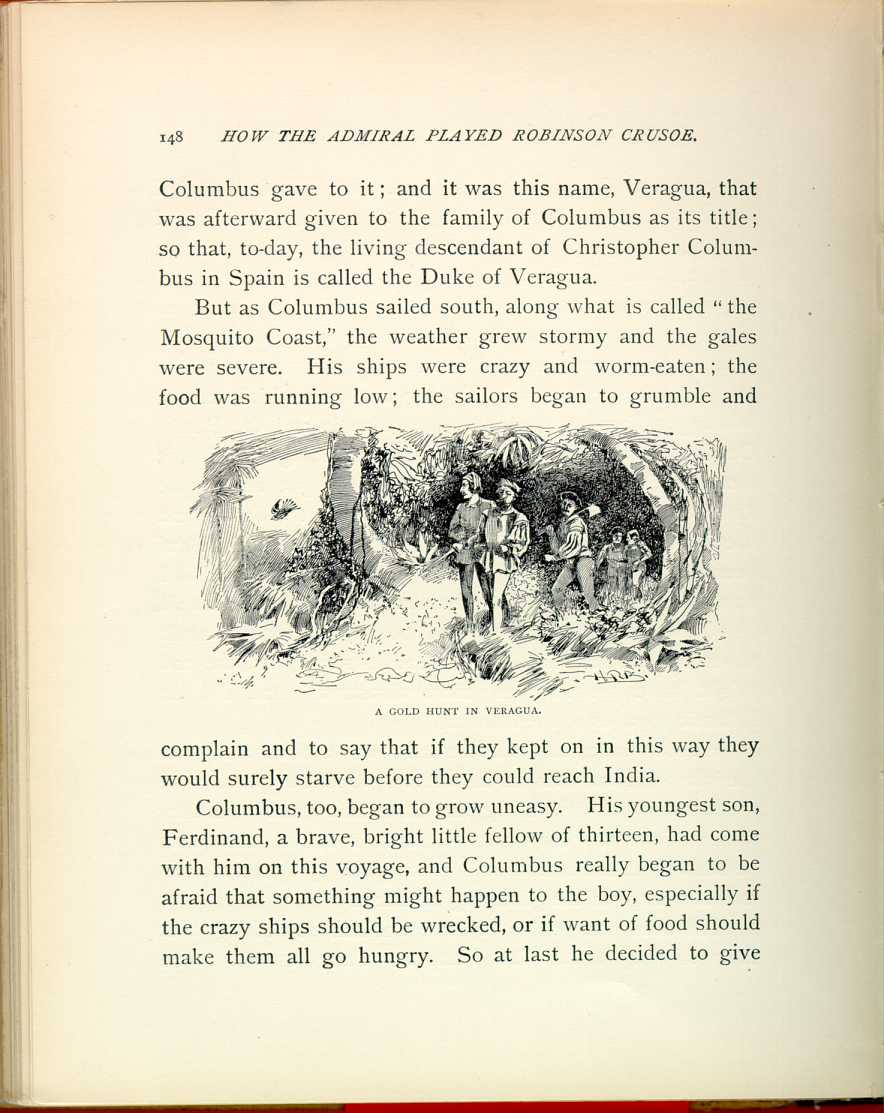
A GOLD HUNT IN VERAGUA.
[Description:
Drawing of several men walking through the Veraguan jungle.
]
Columbus, too, began to grow uneasy. His youngest son, Ferdinand, a brave, bright little fellow of thirteen, had come with him on this voyage, and Columbus really began to be afraid that something might happen to the boy, especially if the crazy ships should be wrecked, or if want of food should make them all go hungry. So at last he decided to give
Here, you see, was still another disappointing defeat for
Columbus. For after he had been on the American coast for almost a
year; after he had come so near to what he felt to be the
long-looked-for path to the Indies; after most wonderful adventures on
sea and land, he turned his back on it all, without really having
accomplished what he set out to do and, as I have told you, steered for
Hayti.
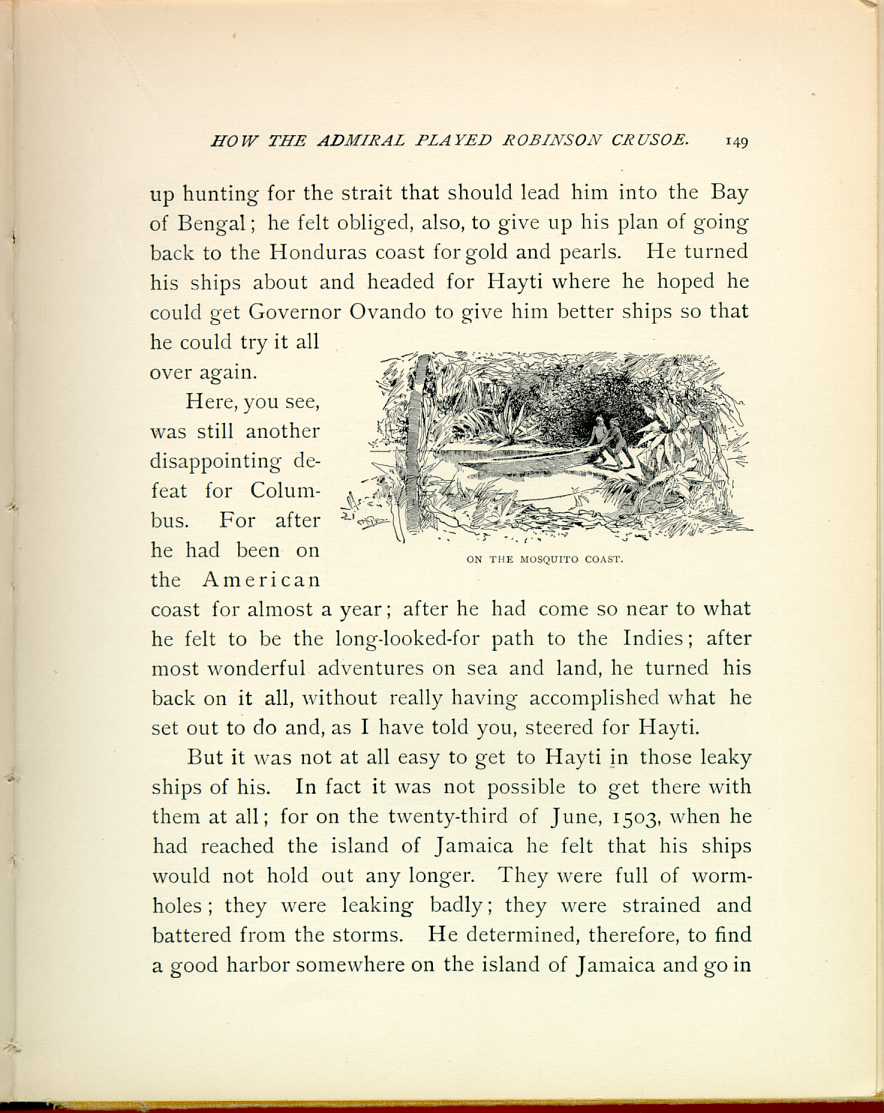
ON THE MOSQUITO COAST.
[Description:
Drawing of two Native Americans pushing a canoe into the water.
]
But it was not at all easy to get to Hayti in those leaky ships of his. In fact it was not possible to get there with them at all; for on the twenty-third of June, 1503, when he had reached the island of Jamaica he felt that his ships would not hold out any longer. They were full of worm-holes; they were leaking badly; they were strained and battered from the storms. He determined, therefore, to find a good harbor somewhere on the island of Jamaica and go in
The castaways lashed the four wrecks together; they built
deck-houses and protections so as to make themselves as comfortable as
possible, and for a whole year Columbus and his men lived there at Sir
Christopher's Cove on the beautiful island of Jamaica.
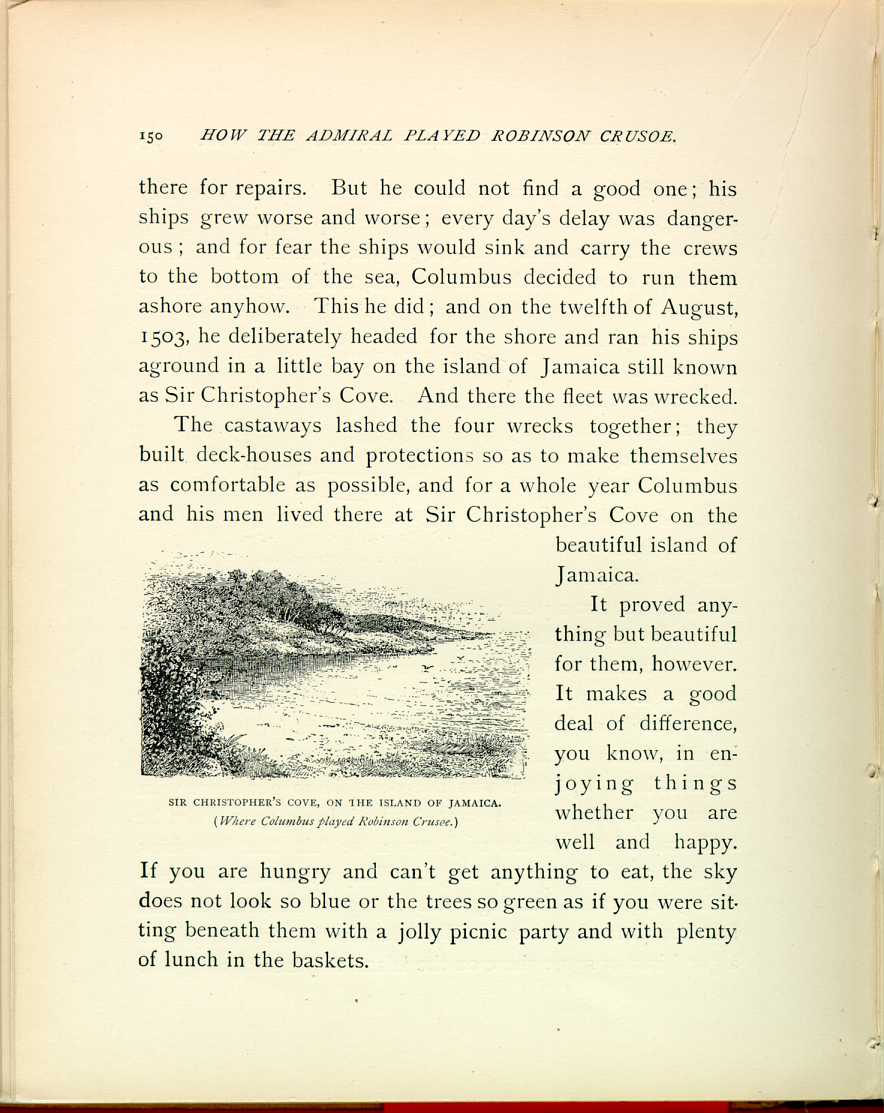
SIR CHRISTOPHER'S COVE, ON THE ISLAND OF JAMAICA.
[Description:
Drawing of the Sir Christopher's cove, on the coast of Jamaica.
]
(Where Columbus played Robinson Crusoe.)
It proved anything but beautiful for them, however. It makes a good deal of difference, you know, in enjoying things whether you are well and happy. If you are hungry and can't get anything to eat, the sky does not look so blue or the trees so green as if you were sitting beneath them with a jolly picnic party and with plenty of lunch in the baskets.
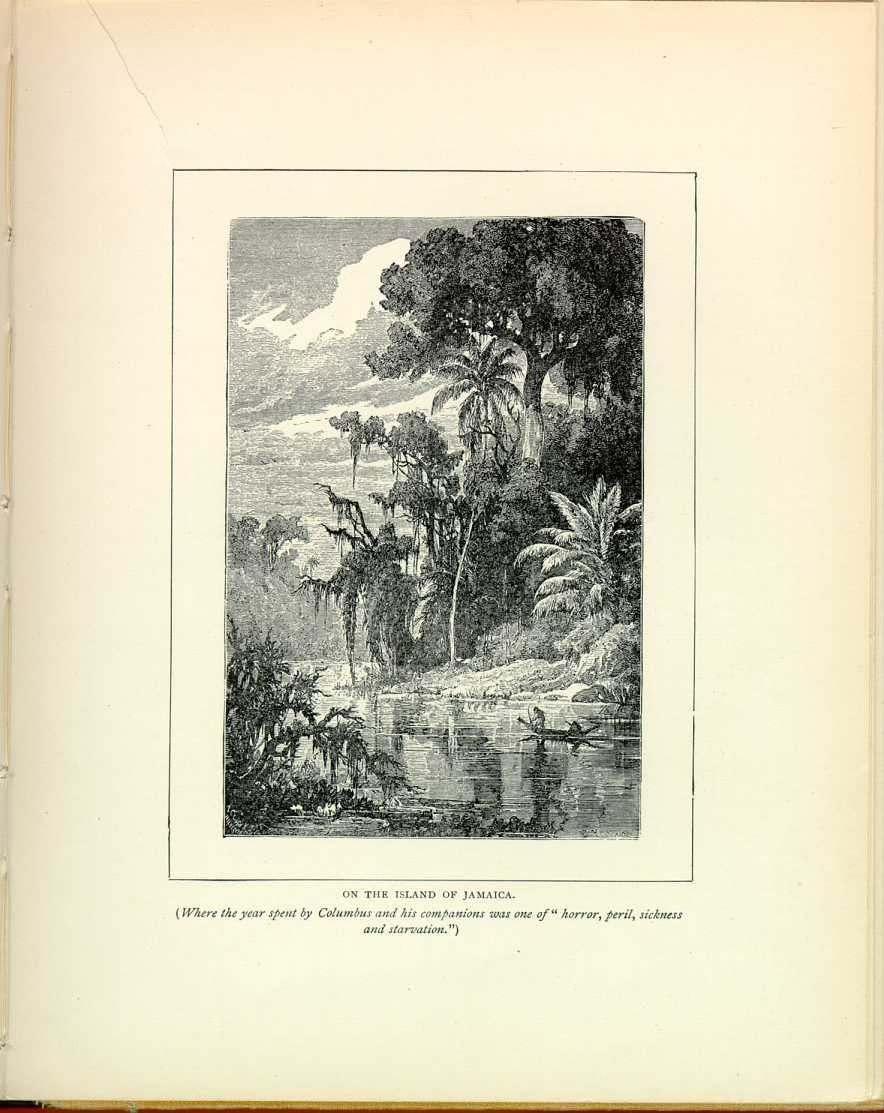
ON THE ISLAND OF JAMAICA.
(Where the year spent by Columbus and his companions was one of "horror,
peril, sickness and starvation.")
[Description:
Drawing of the Jamaican tropical forest.
]
It was no picnic for Columbus and his companions. That year on the island of Jamaica was one of horror, of peril, of sickness, of starvation. Twice, a brave comrade named Diego Mendez started in an open boat for Hayti to bring relief. The first time he was nearly shipwrecked, but the second time he got away all right. And then for months nothing was heard of him, and it was supposed that he had been drowned. But the truth was that Governor Ovando, had an idea that the king and queen of Spain were tired of Columbus and would not feel very bad if they never saw him again. He promised to send help, but did not do so for fear he should get into trouble. And the relief that the poor shipwrecked people on Jamaica longed for did not come.
Then some of the men who were with Columbus mutinied and ran away. In fact, more things happened during this remarkable fourth voyage of Columbus than I can begin to tell you about. The story is more wonderful than is that of Robinson Crusoe, and when you are older you must certainly read it all and see just what marvelous adventures Columbus and his men met with and how bravely the little Ferdinand Columbus went through them all. For when Ferdinand grew up he wrote a life of his father, the Admiral, and told the story of how they all played Robinson Crusoe at Sir Christopher's Cove.
At last the long-delayed help was sent by Governor Ovando, and one day the brave Diego Mendez came sailing into Sir Christopher's Cove. And Columbus forgave the
On the fifteenth of August, the rescued crews sailed into the
harbor of Santo Domingo. The governor, Ovando, who had reluctantly
agreed to send for Columbus, was now in a hurry to get him away. Whether
the governor was afraid of him, or ashamed because of the way he had
treated him, or whether he felt that Columbus was no longer held so high
in Spain, and that, therefore, it was not wise to make much of him, I
cannot say. At any rate he hurried him off to Spain, and on the twelfth
of September, 1504, Columbus turned his back forever on the new world he
had discovered, and with two ships sailed for Spain.

DIEGO MENDEZ GOING FOR HELP.
[Description:
Drawing of two figures leaving the shore of Jamaica in a canoe.
]
He had not been at sea but a day or two before he found that the ship in which he and the boy Ferdinand were sailing was not good for much. A sudden storm carried away its mast and the vessel was sent back to Santo Domingo. Columbus and Ferdinand, with a few of the men, went on board the other ship which was commanded by Bartholomew Columbus, the brother of the Admiral, who had been with
He had been away from Spain for fully two years and a half. He had not accomplished a single thing he set out to do. He had met with disappointment and disaster over and over again, and had left the four ships that had been given him a total wreck upon the shores of Jamaica. He came back poor, unsuccessful, unnoticed, and so ill that he could scarcely get ashore.
And so the fourth voyage of the great Admiral ended. It was his
last. His long sickness had almost made him crazy. He said and did many
odd things, such as make us think, nowadays, that people have, as we
call it, "lost their minds." But he was certain of one thing—the king
and queen of Spain had not kept the promises they had made him, and he
was determined, if he lived, to have justice done him, and to make them
do as they said they would.

STORM-TOSSED IN THE INDIES.
[Description:
Drawing of a storm-tossed ship.
]
They had told him that only himself or one of his family should be Admiral of the Ocean Seas and Viceroy of the New Lands; they had sent across the water others, who were not of his family, to govern what he had been promised for
So, when he was on land once more, he tried hard to get
to court and see the king and queen. But he was too sick.
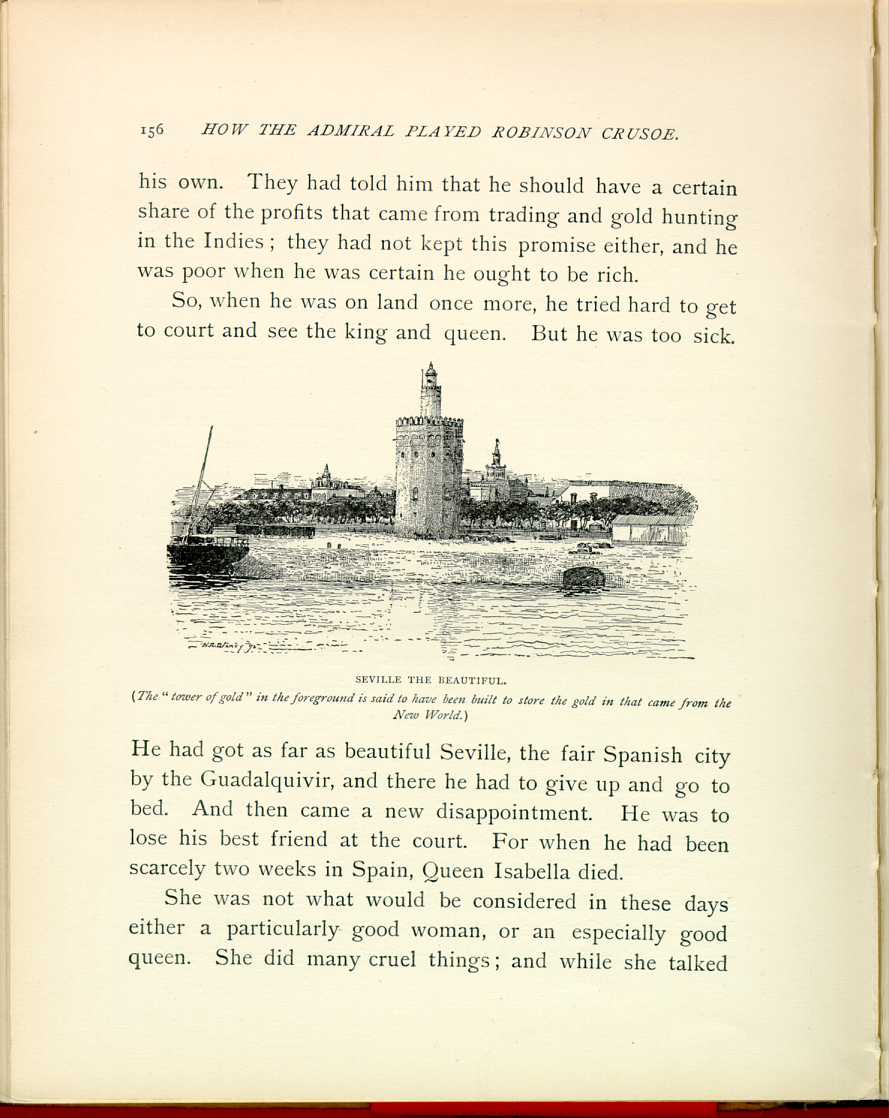
SEVILLE THE BEAUTIFUL.
[Description:
Drawing of Saville with a large tower on the shoreline.
]
(The "tower of gold" in the foreground is said to have been built to store
the gold in that came from the New World.)
She was not what would be considered in these days either a particularly good woman, or an especially good queen. She did many cruel things; and while she talked
Columbus was now a very sick man. He had to keep his bed most of the time, and this news of the queen's death made him still worse, for he felt that now no one who had the "say" would speak a good word for the man who had done so much for Spain, and given to the king and queen the chance to make their nation great and rich and powerful.
|
CHAPTER XII.
HOW THE ADMIRAL PLAYED ROBINSON CRUSOE.
The True Story of Christopher Columbus, Called the Great Admiral | ||